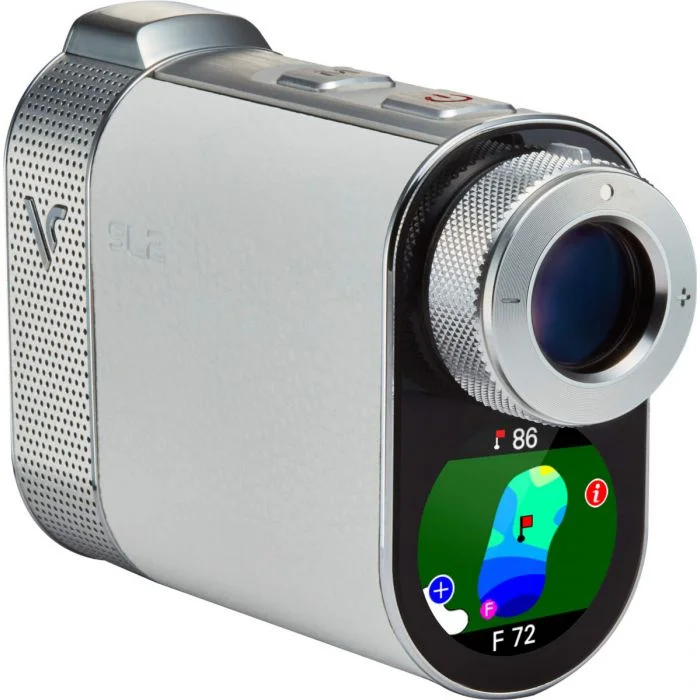
In this article, we will help you understand what rangefinder features are available, how they work, how you can identify what type of rangefinder you need, and ultimately how to choose the best golf rangefinder for yourself.
Overview
There are a ton of features depending on the golf rangefinder you are looking at. We are going to tackle this feature-by-feature, and then have a section to help you identify the best rangefinder for you by type.
Here are the areas we will cover:
- Slope
- Rangefinders vs GPS
- Hybrid rangefinders
- Accuracy
- Display
- Magnification
- Pinseeker technology
- Stabilization
- Speed
- Weather resistance
- Magnetic Attachment
- Battery life
First, let’s start out with helping you understand your needs and what features/tech you really need in a rangefinder to be happy.
How To Choose A Golf Rangefinder

With over 100 golf rangefinders on the market, how do you go about choosing the correct one? Reading individual product reviews can help, but only if you know what features you need, and have figured out how you are going to use the rangefinder.
This may seem obvious, but there are quite a few factors in play to make the right decision. If you don’t want to bother with all of this, read our post on The Best Golf Rangefinders with Slope and pick one of those. That article lists the best-of-the-best, so you can’t go wrong.
However, if you like to do a little more research before purchasing, read on. Use the information in this section to help you evaluate features as we discuss them.
What Kind Of Golfer Are You?
Are you out to have fun and ideally shoot good scores, or are you ultra-competitive and always working on your game to improve? Maybe you play in official competitions under different weather conditions and need the most accurate yardages.
It is something to think about as you want to match the rangefinder to your type of play. If golf is super important to you & you want to play your best, you likely want to get the best rangefinder. They cost less than a driver and will last longer.
If you are a casual golfer but still want accurate yardages, you can still get a premium rangefinder but may not use all of the features offered in the top-of-the-line models.
How Will You Use The Rangefinder?
This is related to the previous question. Here are some questions to consider:
- Will you pull the rangefinder out on every shot?
- Will the rangefinder be your primary distance device, or do you have GPS as well?
- Do you want slope-adjusted yardages?
- Do you play in all types of weather conditions?
- How often do you play?
All golf rangefinders have tradeoffs. For instance the Voice Caddie SL2 has almost every feature conceivable. But the accuracy (+/- 1 yard) is not as good as the Callaway ProXS (+/- .5 yard). Does that matter? Maybe, maybe not. For a pro or high-level amateur that alone could be the deciding point.
But for 99% of golfers, the Voice Caddie SL2 would exceed their expectations. The bottom line is there is that this is about finding the right fit for you.
Slope
Most laser rangefinders on the market today come with a feature called “slope“. This is really the big category differentiator between rangefinders. Either they have slope or not. Note that on you can turn off slope on almost every (if not all) rangefinder that comes with slope to make it tournament legal.
We highly recommend getting a rangefinder with slope. You can always turn it off, but if you buy one without slope you are out-of-luck if you need that feature. The price difference (about 2 cases of ProV1s) is not that much making it worthwhile.
Slope compensates for the elevation change between you and the flagstick and calculates a true yardage.
For example, let’s say you are standing on a hill and looking down at the flagstick. The laser rangefinder will give you the distance to the flagstick, but it will also take into account the fact that you are standing on a hill. This is where slope comes in.
Slope will give you the adjusted distance to the flagstick, taking into account the elevation change.
Slope is a great feature to have if you are playing on a course with a lot of elevation changes. It can help you make more accurate shots and lower your score.
The Downsides to Using Slope Functionality
There can be a few drawbacks to using the slope functionality of a rangefinder, but they can all be mitigated.
- Tournament Restrictions: In tournaments, the use of slope-measuring rangefinders will not be allowed. However, the top slope rangefinders all have visual indicators that slope is turned off. But if you forget to turn it off you could be disqualified.
- Interference with Course Design: The slope measurement function can interfere with the original design and challenge of a golf course, as it may provide players with an advantage that was not intended by the course designer.
- Overreliance: You can become over reliant on it to provide the true distance to a target. While this works great in non-tournament play, you could struggle in tournaments if you can’t figure this out without the slope function turned on.
Ideally, you use the slope function in a practice round and note elevation adjustments in a yardage book. This would help you overcome this limitation and over time you should develop a sense of how uphill/downhill shots paly.
Laser Rangefinders vs GPS Devices
Whether you want a rangefinder or GPS device, there is no wrong answer as to which device is better. Many players carry both devices to get the advantage from each.
There are a few key advantages that a golf laser rangefinder has over a golf GPS device.
First, laser rangefinders are generally more accurate than GPS devices. This is because they use laser technology to measure distance, while GPS devices use satellite technology.
This means that laser rangefinders can be more accurate in measuring distances to the flag, hazards, and other objects on the course. Typically, laser rangefinders are accurate to +/- 1 yard while GPS devices are accurate to +/- 3 yards.
Second, laser rangefinders don’t require a satellite connection in order to function. This means that you can easily carry a laser rangefinder with you on the course, and don’t have to worry about losing a GPS signal. Occasionally satellite reception might be limited which leads to inaccurate yardages.
On the other hand, GPS devices can be attached to your bag, or worn on your wrist providing real-time yardage updates. With GPS, you always see a visual of the hole with yardages to hazards, the green and any target you wish.
Hybrid Laser Rangefinders
Manufacturers also realized the tradeoff between GPS devices and laser rangefinders so they came up with an innovative idea; laser rangefinders with GPS functionality built-in.
These rangefinders incorporate GPS in (2) different ways:
- External display built into the rangefinder
- Internal display with overlaid visuals in the viewfinder

External Display
This innovative design incorporates an external display built right into the rangefinder body.
You get the benefits of a GPS unit and rangefinder with slope. This means hole overviews, hazards, layup distances, green views and more.
Some units also include the undulations on greens.
Units incorporating this design are:
Internal Display
This design is different in that the GPS features are seen when looking through the viewfinder.
The visuals are overlaid on the actual hole you are looking at.
This shows you what hazards are in play around where you are aiming (via the range arc).
Units incorporating this design are:
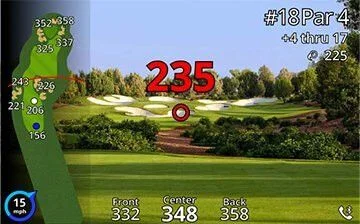
Accuracy
Accuracy is obviously very important for any device that measures distance for golf. As far as rangefinders are concerned though, they all are accurate to +/- 1 yard. This means that whatever you measure, you will be within 3 feet.
Most golf rangefinders talk about accuracy for locking onto the pin & we will cover that in our Pinseeker section below
+/- 1 yard is the standard for golf laser rangefinders, so make sure any model you get has that same level (I have not seen any that are worse). For 99% of all golfers that is more than good enough. To put this in context, GPS devices are accurate to +/- 3 yards.
Laser golf rangefinders get more accurate the closer you are to a target. So you will see even better accuracy from 100 yards than 200 yards–which is where it really counts.
The most accurate golf rangefinders are accurate to +/- .5 yard (1.5 feet). If you want this level of accuracy check out the Callaway ProXS:
How To Identify An Accurate Golf Rangefinder
The optics, laser, build, and environmental conditions all affect the accuracy of a golf rangefinder. This is where the questions we posed above (“what kind of golfer are you?” & “how will you use the rangefinder?”) come into play.
There are several components/areas that determine how accurate a golf rangefinder is. Depending on what you need from your rangefinder, some of these may not matter.
Optics Quality
Optics in a golf rangefinder refer to the lenses and other components that make up the device’s optical system. The optics are responsible for transmitting the laser signal, focusing the image, and providing the magnification. High-quality optics are essential for a rangefinder to provide accurate and clear measurements.
Multicoated lenses and higher magnification are features to look for in premium rangefinders.
Weather Resistance
Environmental conditions can significantly affect the accuracy of a golf rangefinder. Rain, temperature, altitude, fog, and more can reduce the effectiveness of the rangefinder.
Laser
For the most part, you do not need to worry about this unless a rangefinder is using a cheap laser. The most commonly used type of laser in golf rangefinders is a Class 1 laser.
Class 1 lasers are efficient in measuring distances and producing precise readings. Class 3R lasers are used in lower-end rangefinders and are not as accurate.
Display
The display is very important as that is what you see when looking through the viewfinder. In the premium space, the screens are typically OLED which is the best option.
OLED displays can shift colors depending on outdoor conditions. When it is bright out, the data is displayed in red & green. When it is darker out, it switches to black numbers on a gray background. This makes it much easier to see the numbers from the rangefinder.
Less expensive rangefinders use LCD displays. This isn’t necessarily bad though, if that is not important to you.
Magnification
Magnification determines how big the target looks in the display when you are measuring distance. It does not necessarily improve accuracy, but does make it easier to see what you are measuring.
If you lock onto the wrong target, you will get a bad distance. Higher magnification enables you to see better so you measure the correct target.
Most rangefinders have 6X magnification with some offering 7X magnification. The Bushnell Pro X3 and Callaway ProXS both offer 7X magnification.
Pinseeker Technology
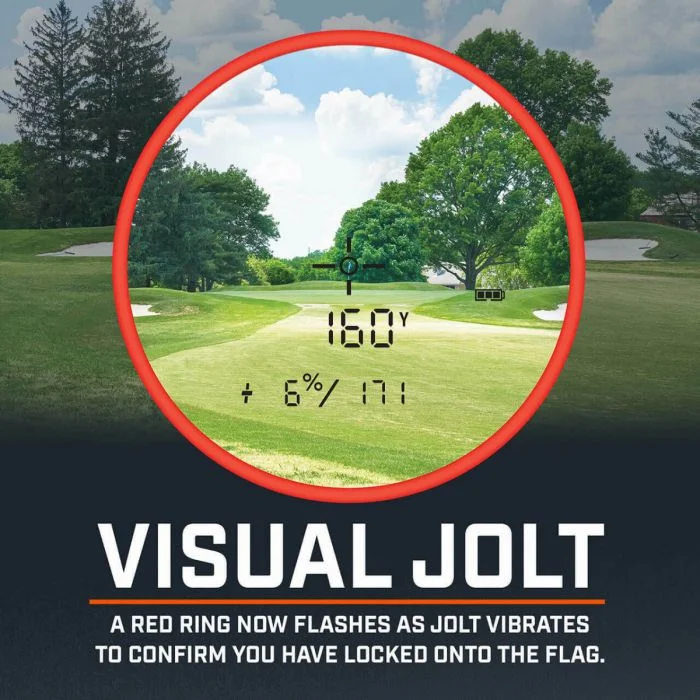
Golf laser rangefinders use a technology called PinSeeker or Pin Acquisition (PA) technology to lock onto the flagstick.
The rangefinder has a small circle or reticle in the viewfinder that is used to aim at the flagstick. When the laser beam hits the flagstick, the reticle will change color or flash to indicate that the flagstick has been acquired and the distance will be displayed on the screen.
Some rangefinders also have multiple targeting modes, such as scan mode, which allows you to measure multiple targets at once, and can help you to find the flagstick among other objects in the background.
This technology can also filter out background objects such as trees and bunkers to ensure that you get an accurate reading to the flagstick.
Identifying Pinseeker Technology
Each brand of golf rangefinder will use their own name for pin acquisition technology. Most brands have their own unique algorithm for this feature. Look for names such as “Pin Assistâ€, “Pin Seekerâ€, “PATâ€, or “Flag Finder†to name a few.
Stabilization
Stabilization helps to improve the accuracy of measurements by using some clever technology.
It typically works by using gyroscopic sensors or image stabilization algorithms to detect and correct any movement of the device. Similar to how cell phone cameras can account for shaky hands, this feature helps you lock onto targets in windy conditions or if you have shaky hands.
Depending on your circumstances this can turn into an absolute requirement for your rangefinder.
Not all rangefinders have this feature and it will cost more to get it (all things being equal).
Speed
Golf can be slow enough so you don’t want to make it worse with a slow rangefinder. This can be extremely frustrating when using a lower-quality rangefinder.
High-end golf rangefinders use technologies such as pulse measurement and selective targeting and can lock onto targets almost instantly. They can return distances within a fraction of a second. Lower-end models may take longer, sometimes up to a few seconds, to lock onto a target.
This can be a difficult metric to research as not all companies publish specs on lock time. However, the premium rangefinders are all going to have near-instant lock times. Typically, you will only run into slow performance on lower-end models.
Weather Resistance
The importance of weather resistance will depend on the conditions you typically play in. For those who play in rainy, humid, or a mix of conditions, this matters a lot. If you only play when the weather is decent you will be fine with any premium rangefinder.
As mentioned above, weather can affect the accuracy of a golf laser rangefinder. Ideally, you use a rangefinder with an IPX4 rating or higher.
IPX (Ingress Protection Rating) is a system of rating a device’s resistance to water and dust. It measures from IPX0 – IPX8, with higher being better.
- IPX4 rating – means the rangefinder is resistant to splashing water from any direction
- IPX7 rating – the rangefinder can be immersed in water up to 1 meter deep for 30 minutes without any damage
Magnetic Attachment
An integrated magnet in the golf rangefinder allows you to stick to any metallic surface such as the bars on an electric golf cart. This means you don’t have to keep putting it back in your bag and makes it super convenient.
Depending on your irons, you can even stick the rangefinder to your iron face for easy pickup. This is actually not a very common feature but golfers who do have it love the ease-of-use.
Battery Life
Battery life is very dependent on the type of rangefinder you have and the type of batteries the rangefinder uses.
Battery Type
Some rangefinders use rechargeable batteries that can take up to 90 minutes to charge (Voice Caddie SL2), but most use a CR2 3-Volt Lithium battery.
Rangefinder Features
The features a rangefinder has can make a major impact on battery life. For instance, a hybrid rangefinder such as the Voice Caddie SL2 has the following battery life:
- 20 hours in GPS + Pin Assist Mode
- 45 hours in Laser mode
Typical golf rangefinders using a CR2 3-Volt Lithium battery will last about 6 months with normal usage.
Conclusion
Hopefully this in-depth look at golf rangefinders has given you the insight to select the best model for you. When it comes to golf rangefinders, most of the time the more it costs, the better it is.
The premium rangefinders use better optics, better parts, have better algorithms, and offer more features. It is worth it to buy a quality rangefinder as it will last years and improve your enjoyment of the game.
Read our post The Best Golf Rangefinders With Slope for our top picks.
Golf Rangefinder Articles
Below is a collection of content we have written on golf rangefinders.
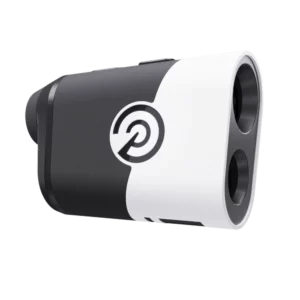
Precision Pro NX9 Review – A Great Golf Rangefinder with Slope!
Precision Pro NX9 Slope Rangefinder Review Introduction Looking for a solid rangefinder with slope to enhance your golfing experience? The…
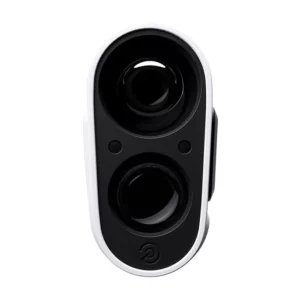
Precision Pro NX10 Rangefinder Review – The Hype Is Real!
Introduction Looking for the perfect golf rangefinder? You’re not alone. The Precision Pro NX10 (with slope) stands out as a…

Callaway 400s Laser Rangefinder Review
Introduction In this comprehensive Callaway 400s Rangefinder Review, we will dig into the details including advanced laser technology and impressive features like Pin…
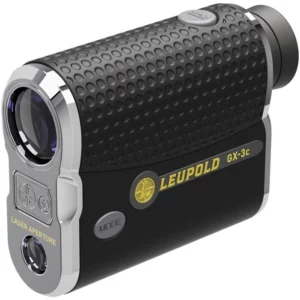
Leupold GX-3C Rangefinder Review
Introduction To The Leupold GX-3C Rangefinder Today we’re diving into an in-depth review of the Leupold GX-3C golf rangefinder a top-notch…

Leupold GX-5C Rangefinder Review
Introduction In this in-depth review of the Leupold GX-5C Rangefinder, we are going to cover the most popular rangefinder from Leupold….
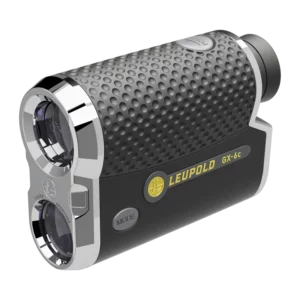
Leupold GX-6C Golf Rangefinder: A Comprehensive Review
Introduction: Why A Reliable Golf Rangefinder Is Essential (2023) In the world of golf, every yard counts. That’s it important…

Cobalt Q-6 Slope Rangefinder Review: A High-End Competitor
Introduction – The Cobalt Q-6 Slope Rangefinder Review In this post we will review the Cobalt Q6 Slope Rangefinder. With…

Nikon COOLSHOT PROII Stabilized Rangefinder Review
Updated June 2023 – added updated specs The Nikon COOLSHOT PROII Stabilized rangefinder has incredible optics and comes with slope….

Bushnell Tour V6 & Bushnell Tour V6 Shift Rangefinder Review
Trusted by 98% of Tour players, Bushnell has improved their premium rangefinders with the release of the Bushnell Tour V6…

The Best Golf Rangefinders With Slope
Are you looking for the best golf rangefinders with slope? This post only focuses on the best of the best….

Bushnell Pro X3 Rangefinder Review
Bushnell is the #1 rangefinder on the PGA Tour. The Bushnell Pro X3 rangefinder takes this to a new level….

How Golf Rangefinders Work
If you want to understand the inner workings of how golf rangefinders work, this article is for you. It will…
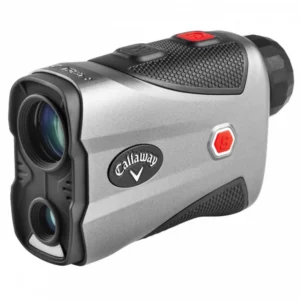
Callaway ProXS Golf Rangefinder Review
The Callaway ProXS golf rangefinder features their most advanced laser technology to deliver accuracy of +/- .5 yards! Offering an…
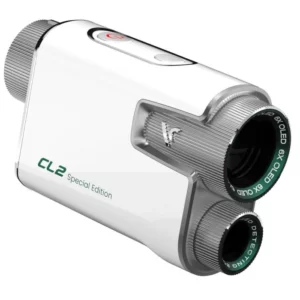
Voice Caddie CL2 Rangefinder Review
The Voice Caddie CL2 Rangefinder is lightning fast & comes in a compact form factor! It includes features such as…
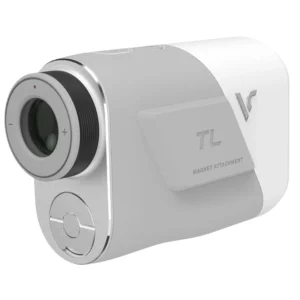
Voice Caddie TL1 Rangefinder Review
With features such as 2-color OLED, V-Algorithm, and a built in magnet the Voice Caddie TL1 Rangefinder is one of…
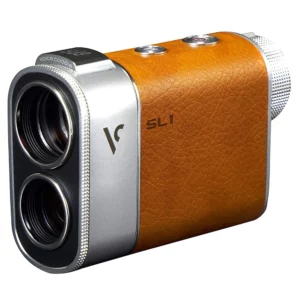
Voice Caddie SL1 Rangefinder Review
In this Voice Caddie SL1 Hybrid Rangefinder review, we will discuss why this rangefinder can replace a GPS device with…
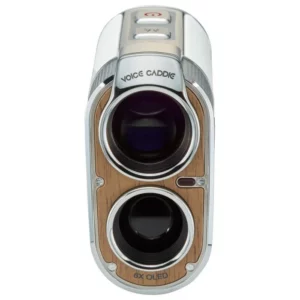
Voice Caddie SL2 Rangefinder Review
In this Voice Caddie SL2 Hybrid Rangefinder review, we will discuss why this can replace a GPS device with this…

Bushnell Tour V5 & Tour V5 Shift Review
Are you looking for a state of the art golf laser rangefinder? Look no further than the Tour V5 from…
PRECISION PRO NX9 Golf Rangefinder
The Precision Pro NX9 Rangefinder offers an enhanced LCD screen and is affordable, making it a cost-effective choice without compromising on quality or features. See our in-depth review for more info.
PRECISION PRO NX10 Golf Rangefinder
The Precision Pro NX10 (with slope) in an incredible performer among its competitors, offering excellent accuracy and full customization. We cover everything you want to know in our review.
CALLAWAY 400S LASER Golf RANGEFINDER
In our Callaway 400s Rangefinder Review, we will dig into the details including advanced laser technology and impressive features like Pin Acquisition Technology (P.A.T.), Slope mode, and waterproof design.
Leupold GX-3C golf rangefinder
The Leupold GX-3C golf rangefinder is a top-notch rangefinder designed to enhance your game and provide accurate distance measurements every time. See our detailed review for more info.
Leupold GX-5C golf rangefinder
The Leupold GX-5C golf rangefinder is the most popular rangefinder from Leupold. Armed with advanced features such as a high-performance DNA engine, fantastic optics, and True Golf Range capability (slope), you can’t go wrong. A great choice.
Leupold GX-6C golf rangefinder
The Leupold GX-6C golf rangefinder is their best model offering Slope, Digitally Enhanced Accuracy (DNA), Club Selector, and more. It adds Image Stabilization (difference from the GX-5C).
COBALT Q-6 SLOPE Golf RANGEFINDER
The Cobalt Q6 Slope Rangefinder is a premium laser rangefinder that offers impressive optics, IPX7 water resistance, and very accurate slope technology. It is a great alternative to Bushnell rangefinders. Click the link to read more.
Nikon COOLSHOT PROII Stabilized Golf RANGEFINDER
The Nikon COOLSHOT PROII STABILIZED Golf Rangefinder has both extremely accurate slope distances and an advanced optical stabilization system to reduce vibration (up to 80%). Includes an OLED display, IPX4 waterproof, and incredible Nikon optics! Click the link to read more.
BUSHNELL TOUR V6 SHIFT Golf RANGEFINDER
The BUSHNELL TOUR V6 SHIFT Rangefinder has an updated PinSeeker algorithm, new electronics, and an improved weather resistance (IPX6). The Shift includes Slope functionality. Click the link to read more about the Tour V6 rangefinders.
Bushnell Pro X3 Golf RANGEFINDER
The Bushnell Pro X3 rangefinder is their top-of-the-line laser rangefinder with slope. It includes a number of improvements over the competition and is perhaps the best golf rangefinder with slope available today. We cover everything in our review.
Callaway ProXS Golf Laser Rangefinder
The Callaway ProXS Golf Laser Rangefinder includes 7X magnification, integrated magnet for attaching to a cart, IPX4 weather resistance, and accuracy to +/- .5 yards. Click the link to read more.
Voice Caddie CL2 Golf RANGEFINDER
The Voice Caddie CL2 golf rangefinder includes 2-color OLED optics, 1-touch pin mode, 6X optics, and more! In our review, we cover the pros & cons. Click the link for more info.
Voice Caddie TL1 Golf RANGEFINDER
The Voice Caddie TL1 rangefinder is their top-of-the-line laser rangefinder with slope (it does not include GPS). Includes 2- color OLED optics, V-Algorithm technology, visual slope indicator, Pin Tracer, and integrated magnet. Click the link to read more.
Voice Caddie SL1 golf rangefinder
Combining GPS and laser into one device, the Voice Caddie SL1 golf rangefinder also features green undulation, auto slope, JOLT, colored LCD, and 6X magnification. Includes a stylish leather finish that sets it apart from the competition. Read the review for more info.
Voice Caddie SL2 golf rangefinder
You get the benefits of a GPS unit and rangefinder with slope. Below the viewfinder, the Voice Caddie SL2 golf rangefinder features a screen that provides useful information such as driver landing area, as well as distance to sand traps and hazards. Read why it is the best hybrid rangefinder with slope on the market.
BUSHNELL TOUR V5 SWITCH Golf RANGEFINDER
The BUSHNELL TOUR V5 SWITCH Golf RANGEFINDER includes PinSeeker with JOLT, 6X magnification, and BITE magnetic mount. Click the link to read more.
HOW GOLF RANGEFINDERS WORK
In our article, How Golf Rangefinders Work, we will help you understand which components and features are most important, and can help you in your search for a great golf rangefinder.
THE BEST GOLF RANGEFINDERS WITH SLOPE
In our review, The Best Golf Rangefinders with Slope, we have narrowed our list to only premium golf rangefinders that offer slope functionality. Click the link to see a more in-depth review.
